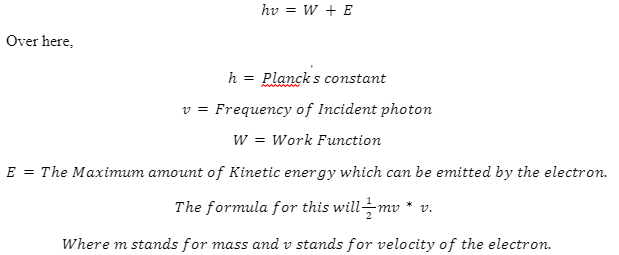The process by which electrons are emitted is known as the Photoelectric effect when there is electromagnetic radiation, like when a material is hit by light. The electrons which get emitted during this process are photoelectrons. This effect is studied in various subjects such as solid-state, quantum chemistry and condensed matter physics to showcase the properties and connections of solids, atoms and molecules. This process can be used in various devices which are specially used to detect light and electron emissions that are accurately timed. It was first discovered by Heinrich Rudolf Hertz in the year 1887. Heinrich Rudolf Hertz was a German physicist.
Photoelectric Effect
The photoelectric effect was first discovered by Heinrich Rudolf Hertz in the year 1887. Heinrich Rudolf Hertz was a German physicist. The process by which electrons are emitted is known as the Photoelectric effect when there is electromagnetic radiation, like when a material is hit by light. The electrons which get emitted during this process are photoelectrons. While working with radio waves. It was noticed by Hertz that when ultraviolet rays reflect on the two metal electrodes when voltage is applied through them, the voltage of the light changes due to which sparkling takes place. The relation which took place between light and energy was also discussed by a German Physicist named Philipp Lenard. It was showcased by him that the electrically charged particles are emitted from the metal electrodes when the metal is illuminated and the particles which are emitted are identical to electrons.
Photoelectric Effect Law
There are a few laws under which Photoelectric Effect takes place. The laws can be termed as:
- The intensity of light is proportional to the photoelectric current for a given frequency of light.
- For any of the given materials, there will be a minimum energy frequency, which will be the threshold frequency.
- As the frequency of the ray or incident light increases the maximum kinetic energy produced by the photoelectrons also increases. The intensity of light does not affect the maximum kinetic energy.
- Emission of Photoelectron is an instantaneous process.
Photoelectric Effect Equation
The Photoelectric Effect Equation can be written as:

This is the Photoelectric Effect Equation.
Application of Photoelectric Effect
Let us look into some applications or uses of the Photoelectric Effect:
- Photoelectric can be used in Solar Panels to generate electricity.
- Photoelectric Effect is also used for motion and Position Sensors.
- In smartphones that have an automatic adjustment for screen brightness the lighting sensors use the Photoelectric Effect.
- XPS which can also be termed X-Ray Photoelectron Spectroscopy.
- Digital cameras use the Photoelectric Effect that helps the camera.
Conclusion
Photoelectric Effect is widely used in today’s world for various types of devices ranging from Smartphones, and cameras to Solar panels and X-ray machines. It was a very important discovery or research made by the German Scientist Heinrich Rudolf Hertz. There are certain laws on which this effect works and there is a proper equation on basis of which the effect can be calculated. In short Photoelectric Effect is very important and useful for a lot of technologies and helps to add more features to certain electronic devices such as smartphones and cameras.
 Profile
Profile Settings
Settings Refer your friends
Refer your friends Sign out
Sign out













